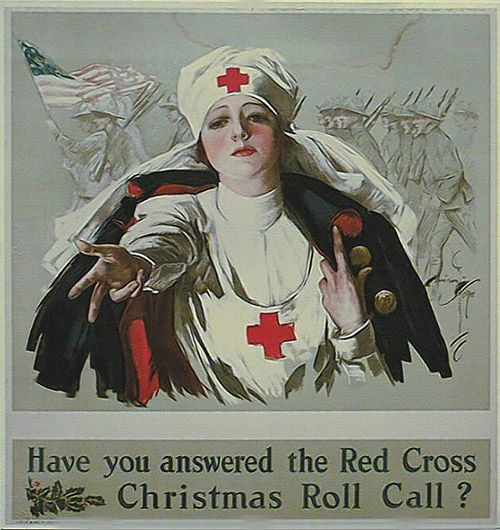
|
|
| In this poster, the Red Cross is asking American women to partake in
the World War I effort. The artist addresses the women of the nation
specifically, but the aim seems to be more toward Caucasian women of the
Christian religious background since the figures are all white and there
are prevalent religious messages. There is an implicit appeal of
religious connotation in that the woman's countenance seems to resemble
the widely used depictions of the Virgin Mary. Mary's head is frequently
shown with a side cant, a posture of humble acquiescence. In addition,
an exaggeratedly high brow, large eyes, and a small mouth are iconographical
features repeatedly employed by painters to represent her spirituality
and lack of sensuality. (1) This portrayal of the woman as the Virgin
Mary strongly reinforces textual insistence on her obedience, submissiveness,
and innocence. (2) These attributes of the Virgin Mary were
strongly urged onto women by prominent Christian leaders of this period.
The approval of God in the Bible, and also the approval of the Church,
of the Virgin Mary as the ideal woman systematically influenced women to
aspire to this role. This is especially important in wartime because
women are leaving the domestic sphere. Since women's social roles
are changing, patriarchal society wishes to remind these women they are
still to embody these characteristics of the Virgin Mary as well as the
feminine qualities of nurturer, mother figure, and virtuous woman.
The colors of the poster are symbolic in that the woman reaching for help is dressed in red, white, and blue. The American flag is also shown in its colors of red, white and blue. However, the remainder of the poster is of a green hue, keeping these images more in the background. In doing this, the artist directly associates the woman with the flag, reflecting the patriotism of her work. The Virgin Mary is most often dressed in white attire and a blue cloak. The addition of the red crosses to her forehead and chest not only signify the organization that the poster is about, but they also hint at a religious connotation and complete the scheme of colors that evokes a patriotic feeling in the viewer. The poster gives the message that the Red Cross work of the women is a patriotic duty to her country, as well the way for her to fulfill more completely the role embodied by the Virgin Mary. The written appeal to women for help is supported by the image of the
woman reaching out her hand, as if to accept other women to join in the
effort to preserve patriotism. The poster uses with good effect the
ideal of the Virgin Mary to call for help from women and at the same time
illustrates gender-specific boundaries of how femininity is constructed
during this period.
1. Margaret Miles, "Violence against Women in the Historical Christian
West in North American Secular Culture, " in Shaping New Vision,
eds. Clarissa W. Atkinson et al. (London: Umi Research Press, 1987),
11-29.
|